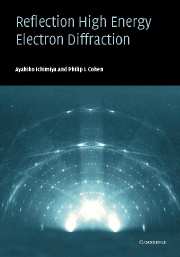Book contents
- Frontmatter
- Contents
- Preface
- 1 Introduction
- 2 Historical survey
- 3 Instrumentation
- 4 Wave properties of electrons
- 5 The diffraction conditions
- 6 Geometrical features of the pattern
- 7 Kikuchi and resonance patterns
- 8 Real diffraction patterns
- 9 Electron scattering by atoms
- 10 Kinematic electron diffraction
- 11 Fourier components of the crystal potential
- 12 Dynamical theory – transfer matrix method
- 13 Dynamical theory – embedded R-matrix method
- 14 Dynamical theory – integral method
- 15 Structural analysis of crystal surfaces
- 16 Inelastic scattering in a crystal
- 17 Weakly disordered surfaces
- 18 Strongly disordered surfaces
- 19 RHEED intensity oscillations
- Appendix A: Fourier representations
- Appendix B: Green's functions
- Appendix C: Kirchhoff's diffraction theory
- Appendix D: A simple eigenvalue problem
- Appendix E: Waller and Hartree equation
- Appendix F: Optimization of dynamical calculation
- Appendix G: Scattering factor
- References
- Index
9 - Electron scattering by atoms
Published online by Cambridge University Press: 06 July 2010
- Frontmatter
- Contents
- Preface
- 1 Introduction
- 2 Historical survey
- 3 Instrumentation
- 4 Wave properties of electrons
- 5 The diffraction conditions
- 6 Geometrical features of the pattern
- 7 Kikuchi and resonance patterns
- 8 Real diffraction patterns
- 9 Electron scattering by atoms
- 10 Kinematic electron diffraction
- 11 Fourier components of the crystal potential
- 12 Dynamical theory – transfer matrix method
- 13 Dynamical theory – embedded R-matrix method
- 14 Dynamical theory – integral method
- 15 Structural analysis of crystal surfaces
- 16 Inelastic scattering in a crystal
- 17 Weakly disordered surfaces
- 18 Strongly disordered surfaces
- 19 RHEED intensity oscillations
- Appendix A: Fourier representations
- Appendix B: Green's functions
- Appendix C: Kirchhoff's diffraction theory
- Appendix D: A simple eigenvalue problem
- Appendix E: Waller and Hartree equation
- Appendix F: Optimization of dynamical calculation
- Appendix G: Scattering factor
- References
- Index
Summary
Introduction
Electrons entering a crystal undergo elastic and inelastic scattering. The main elastic process is Bragg scattering by the atoms. The inelastic scattering processes include plasmon excitations, thermal diffuse scattering and single-electron excitations. As a first step, we describe scattering by a single atom. In this case the inelastic processes are much simpler, being due only to excitations of atomic states. Plasmon scattering and thermal diffuse scattering are described in Chapter 16. In this chapter we describe elastic and inelastic scattering processes for atoms in the Born approximation and calculate differential and total cross sections for special cases.
The main results of this chapter will be expressions for the strength of the scattering and its angular dependence as well as an estimate of the relative elastic and inelastic mean free paths of electrons traveling in a crystal. From the point of view of the subsequent development, though, this chapter need only be examined briefly. Specific references will be made when required.
As described in later chapters, the angular dependences of elastic scattering amplitudes i.e. the electron scattering factors, are used to obtain crystal potentials for the dynamical theory of electron diffraction. The angular dependences of the inelastic scattering intensities contribute to the imaginary potentials in crystals used is the dynamical theory.
- Type
- Chapter
- Information
- Reflection High-Energy Electron Diffraction , pp. 113 - 129Publisher: Cambridge University PressPrint publication year: 2004



